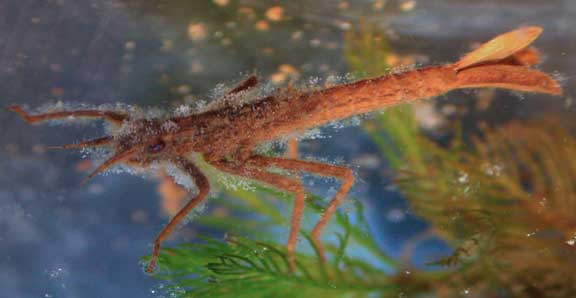

|
|
Biology Photo of the Month - October 2002Damselfly Nymph Covered with Colonial CiliatesPhotos and text by Bill Capman |
|
Augsburg Ecology students collecting stream invertebrates, Minnehaha Creek, October, 2002 |
Fall colors along Minnehaha Creek (roughly halfway between Minnehaha Falls and the Mississippi River, several miles south of Augsburg College (click photo for larger view) |
When we first caught this nymph I was puzzled by its fuzzy appearance. Upon closer examination it turned out to be covered with a dense growth of colonial, stalked ciliates (Vorticella sp., or some similar stalked ciliate). This undoubtedly provides the nymph some degree of camoflauge, but I don't know whether or not these ciliates are harmful to the nymph (I suspect these ciliates are harmless). However, I can say with some certainty that this burden is not permanant, for these ciliates will be shed with the nymph's exoskeleton the next time it molts.
Like other arthropods, this damselfly nymph has an exoskeleton that is shed (molted) periodically as it grows. Before molting, an arthropod develops a new, larger exoskeleton under its older, smaller one. Just prior to molting the animal is packed tight into it's exoskeleton, bulging at the seams, so to speak. After molting, the new exoskeleton expands to its larger size, but it is occupied by the same animal that lived in the older, smaller exoskeleton. Consequently, though an insect looks larger just after molting, and the linear dimensions of its head, legs, and other body parts do in fact increase by quantum leaps with each molt, the insect is sort of skinny just after molting. As it eats and grows, it gradually plumps up and fills out its new exoskeleton .
Though molting is typically described as a way around the limitations on body expansion imposed by a relatively rigid, unstretchable outer body covering, this month's photo suggests an additional benefit for aquatic arthropods. Molting gets rid of organisms that colonize the surfaces of exoskeletons. Pretty much any solid surface in the water will be colonized by aquatic life of some sort. In freshwater habitats the colonizing organisms are typically microorganisms and algae, but in the ocean there is a whole host of sessile organisms that colonize surfaces. Indeed, exoskeletons of marine arthropods such as crabs and shrimp often become colonized by sea life such as algae, tube worms, or other sessile invertebrates, but periodic molting gets rid of these hitchhikers. Some marine arthropods molt throughout life, whether they are still increasing in size or not, but in some crab species molting stops once the crabs reach maturity. Such crabs become increasingly weighed down, a problem that can eventually kill them.

Damselfly nymph covered with colonial, stalked ciliates.
Links
A quick Web search yields many web sites with wonderful photos of Vorticella and other stalked ciliates. Here are just a few:
http://www.micrographia.com/specbiol/protis/cili/peri0100.htm
http://www.microscopy-uk.org.uk/mag/artjan02/telotroch.html
http://protist.i.hosei.ac.jp/PDB/Images/Ciliophora/Vorticella/index.html
See also: